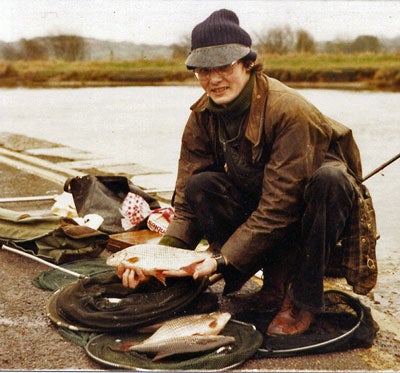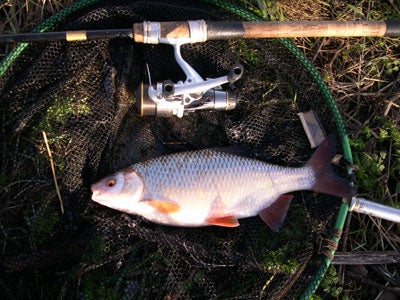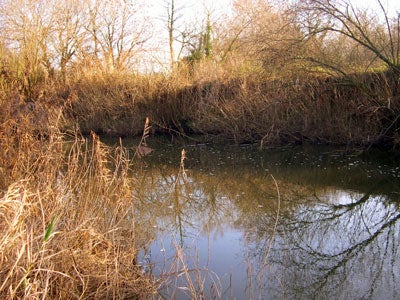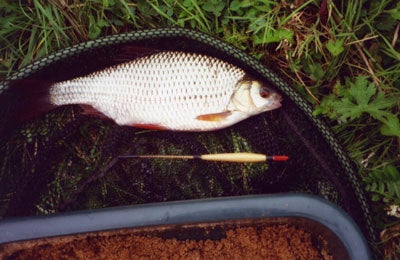| MARK WINTLE |
| Mark Wintle, an angler for thirty-five years, is on a quest to discover and bring to you the magic of fishing. Previously heavily involved with match fishing he now fishes for the sheer fun of it. With an open and enquiring mind, each week Mark will bring to you articles on fishing different rivers, different methods and what makes rivers, and occasionally stillwaters, tick. Add to this a mixed bag of articles on catching big fish; tackle design, angling politics and a few surprises. Are you stuck in a rut fishing the same swim every week? Do you dare to try something different and see a whole new world of angling open up? Yes? Then read Mark Wintle’s regular column. |
| Big Roach in Decline My last article ruffled the odd feather but I had no real axe to grind. What it did do was flush out some truth about the availability of big roach on our rivers. It’s obvious that the shortage of big river roach extends far beyond my local territory of Dorset and western Hampshire. For me and many others this is a worrying trend because I believe that fishing for big roach on a river is one of the most satisfying forms of freshwater fishing around.
I fish for big roach far less than I did more than twenty years ago. I still enjoy catching them but the decline has been so chronic that spending a vast amount of time and effort to track down tiny pockets of big fish on the off chance of eventually nailing one no longer appeals. I still catch plenty of river roach, and the odd one makes a pound and a half. Now and again, with the river perfect, I pick up four or five over a pound in a bag of forty or fifty roach. But the days of hitting into a big shoal of big roach, with few if any under about three-quarters of a pound, seem long past. When Michael Townsend and his mate hit the big roach near Salisbury (plus some magnificent dace) we all got excited, yet to put it into perspective with the Avon’s roach history these catches wouldn’t rate a second glance. At one time, the Avon was one big roach swim with massive amounts of big roach all the way from Salisbury (including the lower Nadder) right down to the Royalty. It is hard to catch any roach at all on many of the stretches that were once famous for huge catches of big roach. Unfortunately, you have to trawl deep into old books to find out much on what was achieved in those far off days, and of course much of what was caught was never recorded. Jack Davis, one-time bailiff on the Royalty is reputed to have had fifty two-pounders in a sitting, and one angling friend of mine had forty in a day from the Parlour over forty years ago (I am still trying to draw out the full details of this catch). The exploits of those privileged to have enjoyed a day fishing from a punt skilfully wielded by the Jefferis brothers at Fordingbridge (or their father Jack before them) told of catches that are mind boggling today. Ninety and a hundred pounds of roach in a day with plenty of two pounders, whilst not commonplace, were recorded in those far off days. Whole stretches abounded with big roach. Just up from the Royalty, Dudmoor, had such a head of big roach that for many years a bag of roach from there held Christchurch AC’s match record with a 64lb bag in four hours by Dob Chislett, and a young Ivan Marks would travel down for the Avon Championship such was the quality of the roach fishing.
The story seems much the same on the Stour. There was a tremendous revival in big roach on the Stour from around 1984 onwards, and this lasted for nearly a decade. This was the legacy of 1975 when a hot summer was followed by a mild winter with no floods. 1976 was hot as well but followed by a wet winter. At that time, and for quite a while after, the cormorants were still controlled, and their effect yet to hit home. It wasn’t until nearly 1990 that cormorant numbers started to impact the Stour. At first it was the really quiet stretches between Blandford and Wimborne that got hit. But it is now evident that, despite the roach’s best efforts to thrive, far too few big ones survive the continuous onslaught. It’s worth attempting to state what the roach fishing was like on the Stour in the sixties. On a number of stretches, Stourpaine, Wimborne and Parley/Throop to name but three, there was some fantastic roach fishing. Bags taken by legends such as Owen Wentworth went as high as over a hundred pounds with many fish between 1/2 a pound and a pound and a half, with two pounders being comparatively rare. Owen seemed to get more of that calibre from the Allen, a tiny chalk stream that is much changed since then, (the stretch he fished was deep and slow, but has now been restored to shallow, gravelly trout water). But massive dredging works on the Stour from Longham to Throop from 1972 to 1975 destroyed the best stretches leaving us puzzled by names such as Dudsbury Deeps, once famed for roach, and now mostly shallow.
Angling Times did a survey, not that long ago, and when it came to anglers’ favourite fish the carp came top with roach in second place. This is hard to interpret but here goes. I think that a lot of experienced anglers like me, and many that come on FM have very fond memories of catching big river roach. Few of us that have fished for twenty or thirty years, especially on rivers, have not caught good bags of roach including some big ones. What very few of us are doing any more is just that; catching good bags of roach, including some big ones on rivers. We’d all love to do it again but are seriously frustrated by the phenomenal damage done by cormorants, and yet seemingly powerless to do much about it. So when it comes to a survey, roach still register high on our favourites for all the right reasons; their beauty, the skill and satisfaction involved in catching them, and so on. Yet all the while we know that deep down our opportunities to catch them are much diminished, and that we’re not actually doing that kind of fishing any more. Twice a year I get to meet with one or two fellow roach enthusiasts at a vintage tackle fair. There’s a familiar conversation that springs up; our hopes are high yet real prospects are worse than ever. It is almost like (bear with me on this) asking the average bloke what his ideal woman is like: blonde, curvy, long legs…. you get the picture, but that’s not the woman he marries. But the story I am telling of the Avon and Stour has been repeated on what was my local river, the Dorset Frome. On there I have records back to the 1930’s, and although it has produced roach over two pounds year in year out, and still does, the real peak of the fishing was, like on the Stour, a fairly short-lived phenomena. It came before that on the Stour, as the Frome started to decline through the aging of the really big fish (around 1984), so the Stour took off. What is hard to figure is whether there is a way back. There are far more small roach in the Frome now than there were over twenty years ago when as many as 40% of roach caught in winter were over two pounds (some days I had four or five roach all over two pounds, and had more over two pounds in a season than under four ounces). But it is getting them past a pound or so in numbers, so that the monsters can be plentiful again, that is impossible to realize.
And that, surely, is the same problem that many other rivers face. Bob Roberts mentioned the Trent; I’ve spoken to Hereford anglers that tell of a similar tale of decline on the Wye. John Bailey’s roach book came out in the mid eighties when the picture was different to today. At that time he wrote of the peaking and subsequent decline of the Wensum roaching from the seventies into the eighties, and since has written of what have since proved to been false dawns of new eras of big roach fishing on the Wensum and other Norfolk rivers. So what’s the real problem with big roach on rivers? Given half a chance they breed well enough. It is a complex subject. When Mark Everard’s book on roach comes out next year I will be interested to see if he has tackled it. The problem has been with us for many years, with declines recognised decades ago on the Wensum and Hampshire Avon. This means that changes to habitat and other environmental factors must be important rather than simply laying all the blame on cormorants as it is so tempting to do. There have been changes to fish populations on all of the waters that have had a big roach decline. Increases in chub and barbel numbers are one of the common factors. If anything, I am finding more roach on some stretches of the Dorset Stour than I did twenty years ago. On the upper river, catches that now run to a hundred fish, were practically unheard of in 1980 yet possible now, but the fewer numbers produced far more big fish. Does this mean that the roach are in effect stunted now, though not in the accepted sense? Yet there are parts of the river that are almost devoid of roach, full stop. One theory of mine that is hard to prove is that if cormorant predation were totally removed, or at least reduced to 1980 levels, then dace would make a comeback at the expense of numbers of roach. This would have a knock-on effect of allowing the smaller numbers of roach that got past ‘dace size’ to take advantage of far less competition for the food that allows roach to grow really big, ie, water snails. I hope one day in the not too distant future that there is a recovery in big roach. Such changes have taken place in the past, and given the dynamics of fishing, are impossible to rule out in the future. What do you think? |

















